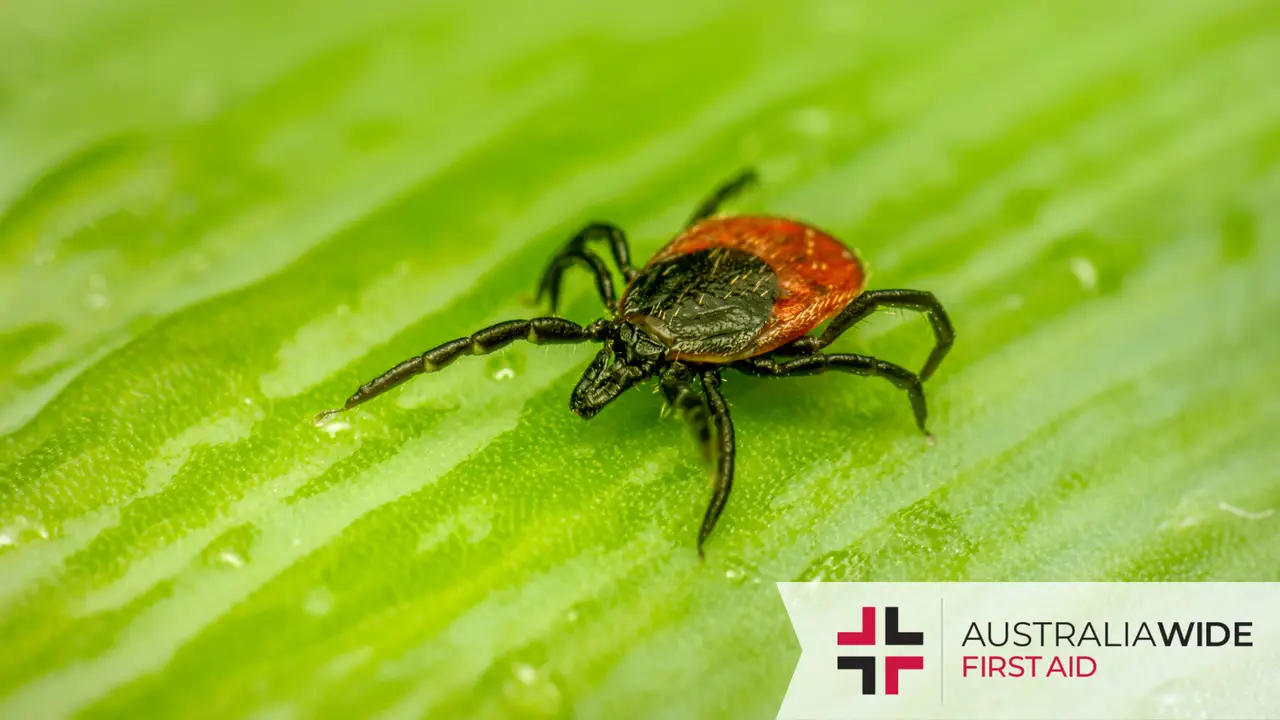3 Most Common Ticks in Victoria


Ticks are ectoparasites that rely on feeding on the blood of humans and animals.
While tick bites are generally benign, they can occasionally provoke an allergic reaction or result in severe illness.
Tick season typically runs from October to March. In Victoria, there has been a recent spike in ticks found on pets and humans. As ticks can be very dangerous to pets, we thought we’d take the opportunity to go over the most common species of ticks in Victoria, symptoms of ticks, and tick removal.
You can also learn how to manage different bites and stings with one of our first aid courses in Victoria.
The bush tick has a flattened, oval-shaped body that can range from brown to dark blue-grey in colour.
The bush tick lives across the entire east coast of Australia, as well as along part of the western coast.
They burrow into the skin of their hosts, which are usually cattle, but can also be pets or humans. On pets, they will typically latch onto fur, and then find exposed skin, including eyes and inside the ears.
While bush ticks don’t cause paralysis, they can cause skin irritation and transmit a number of diseases to dogs, including babesiosis, which can be fatal.
The brown dog tick, Rhipicephalus sanguineus, is a small reddish-brown tick. Its body is flat and elongated, with a narrow head that is longer than it is wide.
This tick is found along the western, northern, and eastern coasts of Australia. They are usually found in kennels, dog houses, and other areas where dogs are kept.
The tick can transmit bacteria to dogs that causes the potentially fatal erhlichia canis. In most cases, these ticks cause skin irritation, or are even harmless. Heavy infestations of them can result in excessive blood loss and anaemia.
The paralysis tick, Ixodes holocyclus, is a small tick that ranges in colour from grayish-blue to dark brown. The female ticks can grow up to 1 cm in length when fully engorged, while males are smaller.
The paralysis tick is found primarily on the east coast of Australia, particularly in coastal and bushland areas. They are commonly found in areas where there is dense vegetation, such as rainforests and scrubland.
In the recent climate, some Melbourne areas have become hotspots for the paralysis tick.
The paralysis tick is known for its ability to cause paralysis in both humans and animals. The tick's saliva contains a neurotoxin that can cause muscle weakness, respiratory distress, and in severe cases, death.
Dogs are particularly susceptible to the effects of the paralysis tick, and can quickly become paralysed if not treated promptly. Signs of these ticks in dogs can include loss of coordination in the hind legs, lethargy, vomiting, and difficulty breathing.
If you are bitten by this tick, you can may develop local itching and rash, lethargy, loss of appetite, weakness, and poor balance. Typically, only children can become paralysed.
If you have been outdoors and have an itch, check the area for ticks before scratching. Ticks can be very small and hard to see.
If you find a tick and are not allergic, remove the tick quickly and safely, and watch for tick-related illness symptoms. You should not squeeze, touch, or forcibly remove a tick, as this makes it more likely to inject its saliva. Ticks should instead be killed with a spray that contains ether (which can be found in pharmacies), and allowed to drop off.
If you are allergic, seek medical attention immediately. Tick bites in Australia have been linked to several illnesses, however, it is important to note that Australian ticks are not known to carry Lyme disease.
To prevent ticks on your pets, you can give them a tick preventative treatment, like tick collars. Keep your yard maintained, clear of debris and with the grass mowed.
You can use tick repellents on yourself as well, and wearing long pants and long sleeves will also help. Likewise, make sure to regularly check your pet/s for ticks, and to perform regular checks on yourself.
For more information about ticks bites on your pets, check out our article on ticks.
And to learn how to identify, prevent and manage different bites and stings, book a general or education setting First Aid course with us today.

March 11, 2025
Darwin, the tropical capital of Australia’s Northern Territory, is home to a rich diversity of wildlife - including an impressive array of spiders. From the sprawling webs of golden orb-weavers to the cryptic camouflage of trapdoor spiders, these arachnids play a vital role in the local ecosystem. While some may inspire fear, the majority are harmless and even beneficial, helping to control insect populations.

September 4, 2024
Cat bites, while often underestimated, can lead to serious health complications if not treated promptly and properly. Cats' mouths harbour a variety of bacteria that can cause infections in humans.

April 1, 2024
Encounters with wildlife can often be thrilling, but when it comes to the creature known as the drop bear, the experience can quickly turn dangerous. A sharp increase in recent attacks prompts the need for understanding proper first aid procedures in case of an attack.